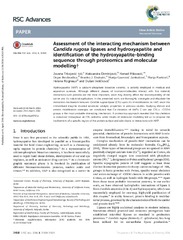Assessment of the interacting mechanism between Candida rugosa lipases and hydroxyapatite and identification of the hydroxyapatite-binding sequence through proteomics and molecular modelling
2016
Аутори
Trbojević-Ivić, Jovana
Dimitrijević, Aleksandra
Milosavić, Nenad
Bezbradica, Dejan

Drakulić, Branko

Gavrović-Jankulović, Marija

Pavlović, Marija
Rogniaux, Helene
Veličković, Dušan
Чланак у часопису (Објављена верзија)
Метаподаци
Приказ свих података о документуАпстракт
Hydroxyapatite (HAP), a calcium-phosphate bioactive ceramic, is actively employed in medical and separation sciences. Although different classes of biomacromolecules interact with this material, interactions with proteins are the most important, since they directly affect the biocompatibility of the carrier and it's industrial application. In the presented work, we thoroughly investigate and elucidate the interaction mechanism between Candida rugosa lipase (CRL) upon it's immobilization on HAP, since this immobilized enzyme showed advanced catalytic properties in previous studies. Applying elution and protein modification strategies we concluded that Ca-chelation of HAP's C-site and CRL's -COOH groups is the most probable interacting mechanism. A proteomics approach revealed that this chelation is conserved throughout all CRL isoforms, while results of molecular modelling led us to propose the involvement of a specific region of the protein surface and side chains in interactions with ...HAP.
Извор:
RSC Advances, 2016, 6, 41, 34818-34824Издавач:
- Royal Soc Chemistry, Cambridge
Финансирање / пројекти:
- Алергени, антитела, ензими и мали физиолошки значајни молекули: дизајн, структура, функција и значај (RS-MESTD-Basic Research (BR or ON)-172049)
- Развој нових инкапсулационих и ензимских технологија за производњу биокатализатора и биолошки активних компонената хране у циљу повећања њене конкурентности, квалитета и безбедности (RS-MESTD-Integrated and Interdisciplinary Research (IIR or III)-46010)
DOI: 10.1039/c6ra07521e
ISSN: 2046-2069
WoS: 000374049700086
Scopus: 2-s2.0-84971642507
Институција/група
Tehnološko-metalurški fakultetTY - JOUR AU - Trbojević-Ivić, Jovana AU - Dimitrijević, Aleksandra AU - Milosavić, Nenad AU - Bezbradica, Dejan AU - Drakulić, Branko AU - Gavrović-Jankulović, Marija AU - Pavlović, Marija AU - Rogniaux, Helene AU - Veličković, Dušan PY - 2016 UR - http://TechnoRep.tmf.bg.ac.rs/handle/123456789/3442 AB - Hydroxyapatite (HAP), a calcium-phosphate bioactive ceramic, is actively employed in medical and separation sciences. Although different classes of biomacromolecules interact with this material, interactions with proteins are the most important, since they directly affect the biocompatibility of the carrier and it's industrial application. In the presented work, we thoroughly investigate and elucidate the interaction mechanism between Candida rugosa lipase (CRL) upon it's immobilization on HAP, since this immobilized enzyme showed advanced catalytic properties in previous studies. Applying elution and protein modification strategies we concluded that Ca-chelation of HAP's C-site and CRL's -COOH groups is the most probable interacting mechanism. A proteomics approach revealed that this chelation is conserved throughout all CRL isoforms, while results of molecular modelling led us to propose the involvement of a specific region of the protein surface and side chains in interactions with HAP. PB - Royal Soc Chemistry, Cambridge T2 - RSC Advances T1 - Assessment of the interacting mechanism between Candida rugosa lipases and hydroxyapatite and identification of the hydroxyapatite-binding sequence through proteomics and molecular modelling EP - 34824 IS - 41 SP - 34818 VL - 6 DO - 10.1039/c6ra07521e ER -
@article{
author = "Trbojević-Ivić, Jovana and Dimitrijević, Aleksandra and Milosavić, Nenad and Bezbradica, Dejan and Drakulić, Branko and Gavrović-Jankulović, Marija and Pavlović, Marija and Rogniaux, Helene and Veličković, Dušan",
year = "2016",
abstract = "Hydroxyapatite (HAP), a calcium-phosphate bioactive ceramic, is actively employed in medical and separation sciences. Although different classes of biomacromolecules interact with this material, interactions with proteins are the most important, since they directly affect the biocompatibility of the carrier and it's industrial application. In the presented work, we thoroughly investigate and elucidate the interaction mechanism between Candida rugosa lipase (CRL) upon it's immobilization on HAP, since this immobilized enzyme showed advanced catalytic properties in previous studies. Applying elution and protein modification strategies we concluded that Ca-chelation of HAP's C-site and CRL's -COOH groups is the most probable interacting mechanism. A proteomics approach revealed that this chelation is conserved throughout all CRL isoforms, while results of molecular modelling led us to propose the involvement of a specific region of the protein surface and side chains in interactions with HAP.",
publisher = "Royal Soc Chemistry, Cambridge",
journal = "RSC Advances",
title = "Assessment of the interacting mechanism between Candida rugosa lipases and hydroxyapatite and identification of the hydroxyapatite-binding sequence through proteomics and molecular modelling",
pages = "34824-34818",
number = "41",
volume = "6",
doi = "10.1039/c6ra07521e"
}
Trbojević-Ivić, J., Dimitrijević, A., Milosavić, N., Bezbradica, D., Drakulić, B., Gavrović-Jankulović, M., Pavlović, M., Rogniaux, H.,& Veličković, D.. (2016). Assessment of the interacting mechanism between Candida rugosa lipases and hydroxyapatite and identification of the hydroxyapatite-binding sequence through proteomics and molecular modelling. in RSC Advances Royal Soc Chemistry, Cambridge., 6(41), 34818-34824. https://doi.org/10.1039/c6ra07521e
Trbojević-Ivić J, Dimitrijević A, Milosavić N, Bezbradica D, Drakulić B, Gavrović-Jankulović M, Pavlović M, Rogniaux H, Veličković D. Assessment of the interacting mechanism between Candida rugosa lipases and hydroxyapatite and identification of the hydroxyapatite-binding sequence through proteomics and molecular modelling. in RSC Advances. 2016;6(41):34818-34824. doi:10.1039/c6ra07521e .
Trbojević-Ivić, Jovana, Dimitrijević, Aleksandra, Milosavić, Nenad, Bezbradica, Dejan, Drakulić, Branko, Gavrović-Jankulović, Marija, Pavlović, Marija, Rogniaux, Helene, Veličković, Dušan, "Assessment of the interacting mechanism between Candida rugosa lipases and hydroxyapatite and identification of the hydroxyapatite-binding sequence through proteomics and molecular modelling" in RSC Advances, 6, no. 41 (2016):34818-34824, https://doi.org/10.1039/c6ra07521e . .


